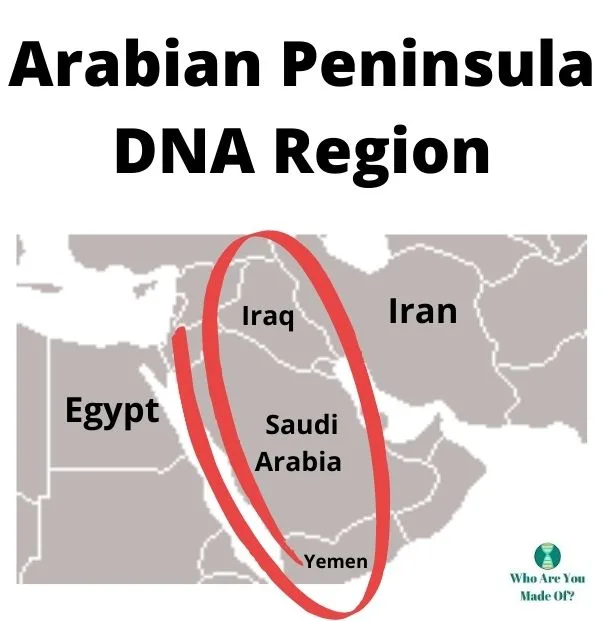If you got the Arabian Peninsula region in your Ancestry DNA results, you have come to the right place to learn more. Here you will find out where this region is located, how you inherited DNA matching this region, and how to trace your Arabian Peninsula ancestry.

While there are no definite numbers, estimates suggest that there many millions of people living all around the world with at least some portion of their ancestry from the Arabian Peninsula. For example, in the United States, there are an estimated 3.7 million members of the Arab disapora with known ancestry from the region.
There are significant populations of people with Arabian Peninsula ancestry living in Brazil, France, Turkey, Indonesia, and Argentina, among many other countries. In other words, if you received the Arabian Peninsula DNA region on your Ancestry results, you are in excellent company.
Where is the Arabian Peninsula DNA Region on Ancestry located?
The Arabian Peninsula DNA region is located on the western portion of the continent of Asia. Most of the region is bordered on three sides by the Persian Gulf, the Gulf of Oman, the Red Sea and the Arabian Sea.
The map below shows the approximate location of the Arabian Peninsula DNA region circled in red. As you can see, this ethnicity region is between the countries of Iran to the east and Egypt, Sudan, and Ethiopia to the west.

The Arabian Peninsula has historically been a crucial connection between Africa and Asia. Humans have been living in the region for at least 120,000 years, and the cultures of the region have been very important for the development of modern civilization.
The Arabian Peninsula and its people have had a dramatic influence on religion through the spread of Islam, which originated in the region. The modern understanding of mathematics, medicine, astronomy, architecture, navigation and geography, and even horticulture, all developed with contributions from cultures and people from the Arabian Peninsula.
Many languages, including English and Spanish, widely spoken in Western Civilizations, have thousands of words with origins in Arabic, the main language spoken on the Arabian Peninsula.
Which countries are part of the Arabian Peninsula DNA region?
The countries included in the Arabian Peninsula DNA region are Saudi Arabia, Qatar, Kuwait, Iraq, United Arab Emirates, and Yemin.
Many people viewing their results could assume based on the name of the DNA region that Saudi Arabia, the largest country in the area, is their source of their results. This often occurs with any large region that encompasses multiple countries, such as the "Germanic Europe", which isn't only found in Germany.
Even though Saudi Arabia certainly is the largest country in this DNA region, there are populations of Arabian people living in many neighboring countries. There are linguistic, cultural, ancestral, geographical, and sometimes even political ties between Arabs across the region.
It is important to note that there are other ethnic groups other than those who would identify as Arab or of Arabian origin living within these countries, which means that if you have ancestors from the region and do not see Arabian Peninsula on your results, this is one possible explanation. For example, Iraq has a large population of people of Kurdish origin, with historic ties
How did you get Arabian Peninsula DNA in your Ancestry results?
If you currently live outside of the Arabian Peninsula DNA area and received this region on your Ancestry results, you likely have ancestors who called this place home within the past 200 years. A very small percentage, such as less than 5%, matching the region could indicate more distant Arabian Peninsula heritage.
Did another region change to Arabian Peninsula?
If you tested with Ancestry DNA prior to September 2021, you might have noticed that your results now say Arabian Peninsula, but previously matched a region with a different name. Some people may have seen the "Middle East" DNA region on their results, yet now see Arabian Peninsula instead.
Ancestry regularly updates our results as technology and science improves in order to provide more specific and accurate results.
Even though your previous results may not have indicated ancestry specifically from the Arabian Peninsula region, it does not mean that they were incorrect. As AncestryDNA works to refine the ethnicity estimate technology, we will occasionally see our general regions become more specific, such as is the case with the Arabian Peninsula region.
You may have inherited DNA matching the Arabian Peninsula from ancestors from a nearby region
If you have known ancestors in your family tree from regions adjacent to the Arabian Peninsula DNA countries, you may have inherited DNA matching the region through them. It is very common for people living in one area to have ancestors from neighboring regions.
Other DNA regions close to the Arabian Peninsula region on Ancestry include:
- The Levant
- Iran/Persia
- Anatolia & the Caucasus (Turkey)
- Egypt
- Ethiopia & Eritrea
If you were surprised to find the Arabian Peninsula in your Ancestry results and you have ancestors from any of the above regions, you might consider researching those lines of your family tree thorough in order to see if these individuals may have had ancestors who originally lived in the Arabian Peninsula region.
How to trace your ancestors from the Arabian Peninsula region in West Asia?
Fortunately, whether you believe your ancestry from West Asia, and the Arabian Peninsula or Iraq, specifically, do be distant or recent, there are effective strategies that you can use to identify the ancestors from whom you likely inherited this DNA. Below, learn the three steps you should take to begin your research.
Talk to your older relatives to identify ancestry from the Arabian Peninsula
The first, and most important, step is to begin the process of speaking with your older family members, if it is possible for you. Our older relatives, when available to speak with, will always be the best source of information about our recent family history.
Family stories and details about where your more recent ancestors were born will help you identify which lines of your family tree you should examine more closely to identify your Arabian Peninsula ancestors.
A family history interview can be done in a formal or informal setting, and can occur across several conversations, or just one. You might also consider including questions about your family's cultural heritage, too, since this aspect of family history often overlooked, yet crucial for understand the family story.
It is important to take good notes during and after your conversations with your relatives. I know that I have often forgotten important details described to me by my relatives when I am not writing things down.
Build a family tree to trace your family lines to the Arabian Peninsula countries
The second step to tracing your ancestry from the Arabian Peninsula DNA region on Ancestry is to build a simple family tree based on what you already know about your ancestors, as well as the information learned through the conversations with your relatives.
Ideally, you will be able to build a family tree that goes back as far as your great-great grandparents on all lines of your tree. This means that your goal is to have sixteen great-great grandparents, eight great-grandparents, four grandparents, and of course, two parents, in your tree.
If you are able to achieve this, you likely be able to identify the most likely ancestor who passed down DNA matching the Arabian Peninsula to you. You can then apply some basic family tree building strategies using documents such as census and vital records, in order to build your tree back a little further on their line.
Research your DNA matches to learn more about your connection to your Arabian Peninsula ancestors
Finally, you will almost definitely find that your DNA matches are a very valuable source of information about your Arabian Peninsula ancestry. Your DNA matches can help you identify which line of your family tree has heritage in the region, confirm how far back in your tree this ancestor might be, as well as learn the identity of the ancestor, in some cases.
For example, if you have a high percentage (over 10-20%) Arabian Peninsula DNA in your results and you have 4th cousin or closer DNA matches that only have that region in your results, you might be able to identify
Tip: Before you get started analyzing your DNA matches, be sure that you have attached your DNA results to your tree. This gives you access to extra AncestryDNA features such as ThruLines and Common Ancestor Hints.
Conclusion
I hope that you enjoyed this article about the Arabian Peninsula DNA region on Ancestry, and that you are inspired to start building a family tree to discover more about your ancestors from this area.
If you have any questions about something that you have read in this post, or if you know where your Arabian Peninsula ancestors were from and you would like to share, please join us in the discussion below.
Thanks for stopping by today!
